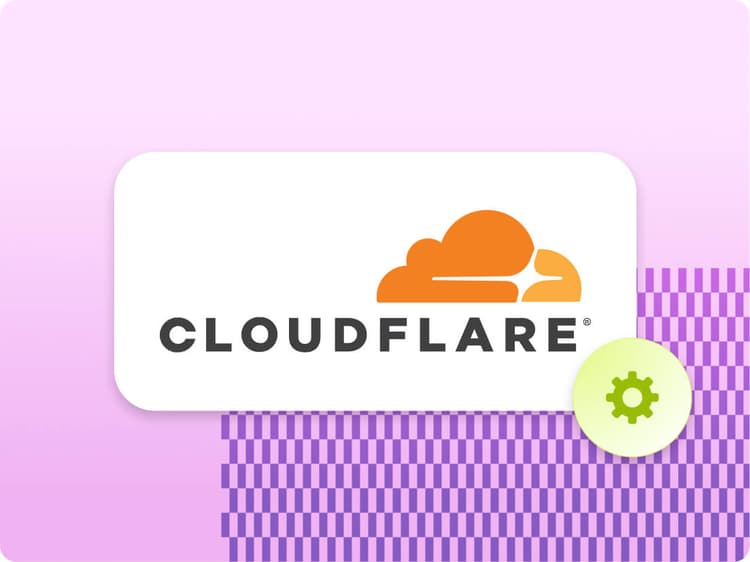
Cloudflare Setup
The following screenshots illustrate how to configure Cloudflare to deliver content. Essential settings are marked with a red circle.
This setup can be completely done in the browser by using the Cloudflare Dashboard only. If you are already familiar with Cloudflare Workers, Wrangler & GitHub and not afraid of entering commands in a terminal window you might want to follow the instructions for Cloudflare with wrangler instead.
Create a Cloudflare site
If you already have a Cloudflare site and DNS set up you can skip forward to the Setup push invalidation section.

Enter the domain:

Select a plan:

For this walk-through we’ll use the Free plan.
DNS Setup
For a new site, we’ll start with a simple DNS setup.
- Create a new
CNAMErecord. If your zone ismysite.comand you want to serve traffic onwww.mysite.com, then the name should bewww - If you want to serve traffic on example.com (without a www) then the name should be
@ - And if you want to serve traffic on all subdomains, then the name should be
* - As we are using workers to serve the content, the value of the Content field does not matter. It’s easiest to use your
ref--repo--owner.aem.livehost name here. This is a hostname, not a URL, so leave out the leadinghttps://
Make sure the CNAME record is Proxied:

SSL/TLS Setup
Select SSL/TLS from the left pane and Edge Certificates in the dropdown list. On the right side, scroll down to Always Use HTTPS and enable the setting:

Configure Caching
Navigate to Caching → Configuration and adjust following settings:
- Caching Level: Standard
- Browser Cache TTL: Respect Existing Headers

Create Cache Rules
Next browse to Caching → Cache Rules and create a new cache rule

Note: Enable Origin Cache Control option is only available for enterprise accounts. Free, Pro, and Business customers have this option enabled by default and cannot disable it.

Following settings should apply:
- When incoming requests match: hostname contains
mydomain.com - Then: Eligible for cache
Under Browser TTL, click "add setting", then apply "Respect Origin TTL"
Create Worker
Return to the Cloudflare Dashboard homepage, then navigate the sidebar: Workers & Pages → Overview. Click "create" to create a new worker.

On the next screen, click "create worker", because that's what you want to achieve.

Enter a name for the worker (e.g. aem-worker) and click on “Deploy”:

On the next screen, click "Edit code"

Edit worker code
- Copy the content of this file.
- In the left pane, replace the existing content with the copied content.
- Click on “Deploy”
- Confirm with "Save and Deploy"
Note: If you are using the recommended content-security-policy with ‘strict-dynamic’ and (cached) nonce , please make sure to use the latest worker code, which removes the header in 304 responses, to ensure that there is no mismatch between the nonce cached in your site user’s browser and the one returned by the server.

Return to your worker (by clicking the back arrow in the top right corner), then click on Settings → Variables and “Add variable”:
Add a variable ORIGIN_HOSTNAME and set the value to the hostname of your origin (e.g. main--mysite--aemsites.aem.live):

If you have enabled push invalidation, add a second environment variable PUSH_INVALIDATION = enabled.
Apply the changes by clicking "Deploy".
Next, click on Triggers an select “Add route”:

Enter your domain route (e.g. www.mydomain.com/*), select your zone and confirm with “Add route”:

Depending on the setup chosen in DNS Setup, you would select routes www.mydomain.com/* or mydomain.com/*
Warning: if you select *.mydomain.com/* as Cloudflare suggests in the field default, your site will be available under multiple subdomains. This will invite attackers trying to open webmail.mydomain.com and similar sites, and lead to duplicate content, potentially depressing your search engine rankings.
After completing all steps you should be all set.
Optional: Authenticate Origin Requests
When using token-based Site Authentication, add the following to enable authenticated requests from Cloudflare to AEM.
- Return to Workers → <your worker> → Settings → Variables
- Create a new environment variable
ORIGIN_AUTHENTICATION - Paste the site token value from token-based Site Authentication (it starts with
hlx_) - Confirm by clicking "Deploy"

Expanding the AEM footprint on your website
In case you start with having only a portion of the website being routed to your .live origin and have routed a specific folder (eg. /blog/*) you can subsequently add more routes whenever you are ready to expose new sections of the site by simply adding more routes and repeat the last “add route” steps as needed, without changing your worker configuration.
Watch out for duplicate content
Search engines often penalize sites for duplicate content, so it's important to make sure your content is not available on the web elsewhere. Cloudflare, unfortunately, has a default setting that will expose your site on additional network ports. In paid Cloudflare plans you can block traffic on these additional ports. This is a recommended setting for production sites.
Previous
